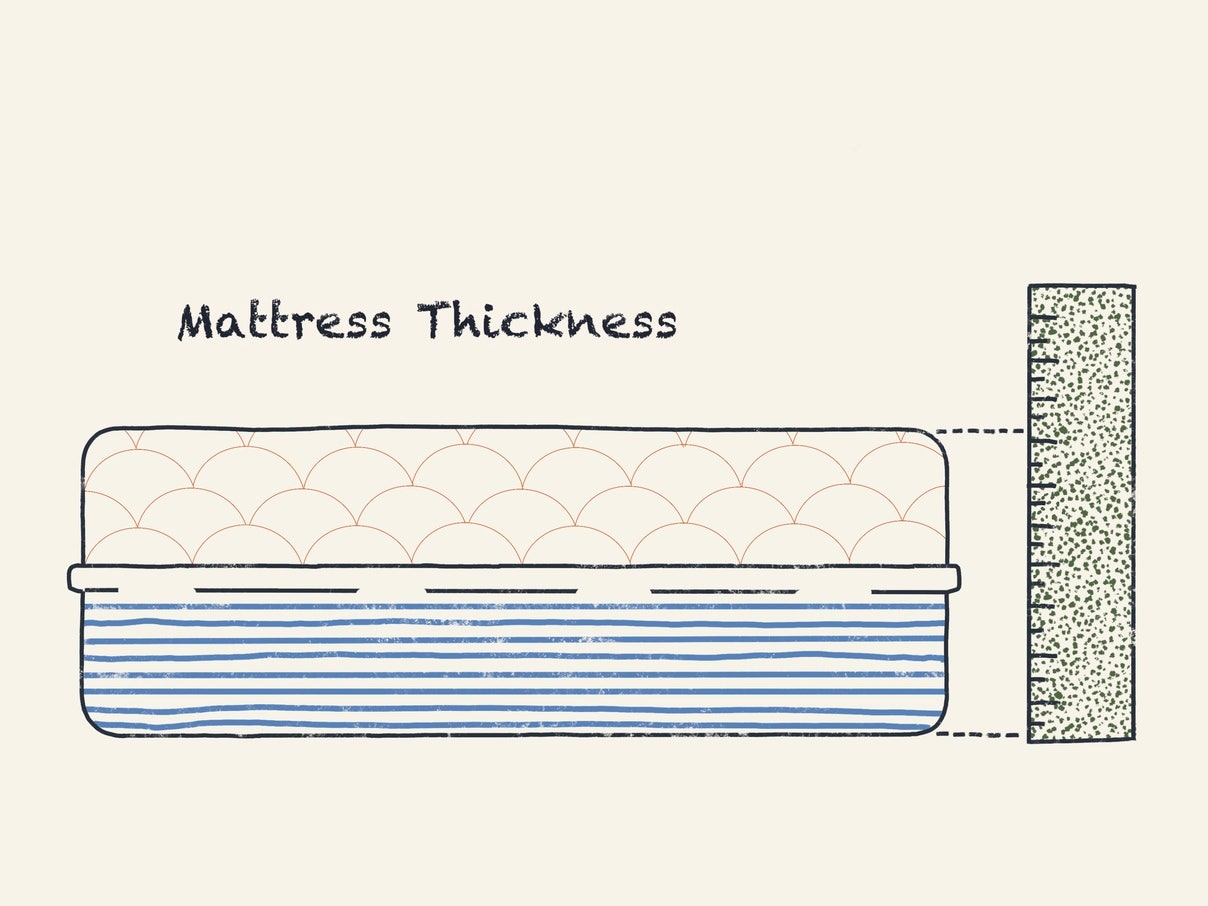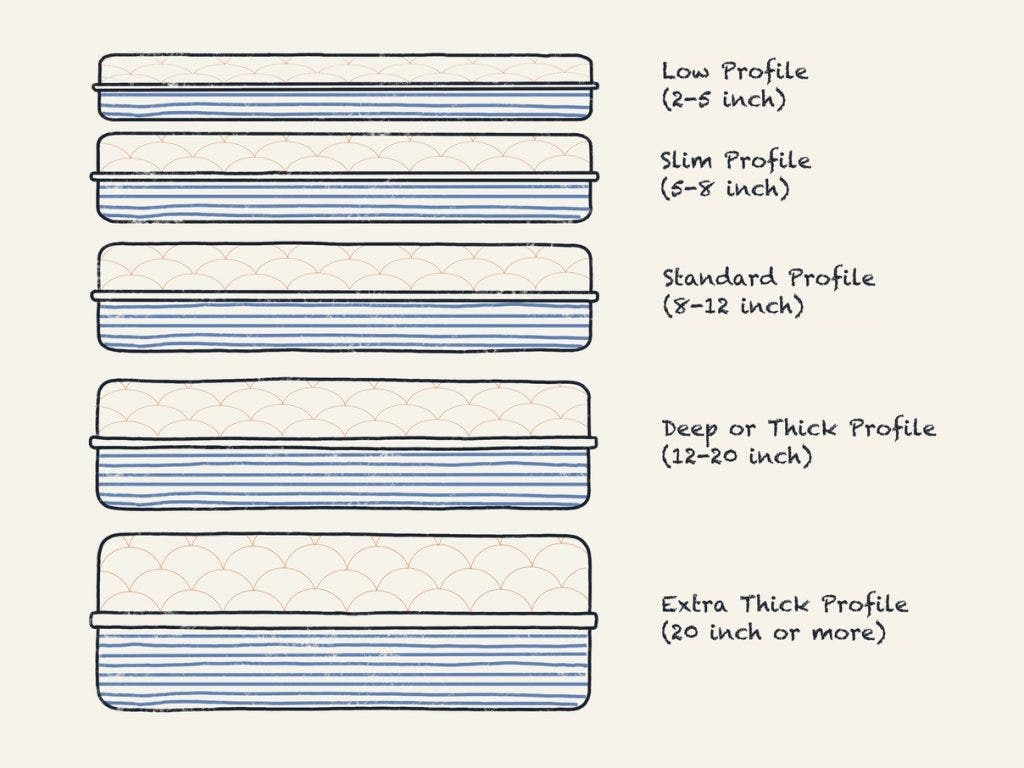Sleep Health
Published March 1, 2022
14 minMattress Thickness Guide
Most people will agree that there's nothing close to the surreal feeling of sinking into a thick-and-plush mattress after a long, tiring day. But, how thick should a mattress be exactly to be able to

Table of contents
Mattress Thickness ChartFactors That Influence the Mattress ThicknessMattress Thickness BreakdownMattress Type Vs ThicknessHow to Choose the Right Mattress ThicknessBenefits of Thick MattressDrawbacks of Thick MattressFrequently Asked Questions
Most people will agree that there's nothing close to the surreal feeling of sinking into a thick-and-plush mattress after a long, tiring day. But, how thick should a mattress be exactly to be able to render 'that' comfort? Well, it depends. Mattress thickness is essential because a mattress that's too thin may wear out soon or strain your back, while one that's too thick may negatively impact your sleep quality.When purchasing a new, different size mattress, there are ample things to consider – bed base size, sleeping positions, body types, the available choices, and the overall desired bed appearance. This guide aims to break down all these details and give you an idea of which mattress thickness best complements your needs and what to consider when deciding on mattress thicknes

Mattress Thickness Chart
There is no 'one' universal size that suffices everyone's requirements when it comes to mattress thickness. Different people prefer (or need) different mattress thicknesses. However, most varieties of good-quality mattresses are somewhere between 8 and 14 inches in thickness.The chart below summarizes the various thickness levels available in the market. It explains how they group mattresses:| Thickness | Mattress Type |
|---|---|
| 2 to 5 Inches | Low Profile |
| 5 to 8 Inches | Slim Profile |
| 8 to 12 Inches | Standard Profile |
| 12 to 16 Inches | Deep, Thick, or Tall Profile |
| More than 16 Inches | Extra Deep, Extra Thick, or Extra Tall Profile |
2 To 5 inches
A mattress with a thickness of 2 to 5 inches is considered to be a low-profile mattress. It is an excellent choice for light sleepers and kids. A low-profile mattress is Ideal for stowaway beds and bunk beds.5 To 8 inches
A mattress with a thickness of 5 to 8 inches counts as a slim profile mattress. Slim mattresses with layers of foam serve as great options for people with limited mobility.8 to 12 inches
A mattress with a thickness of 8 to 12 inches is known to be a standard profile mattress. This is the average mattress thickness that works well with most adults.12 to 16 inches
A mattress that has a thickness between 12 to 16 inches is called a deep, thick, or tall profile mattress. These are soft and durable and ideal for plus-sized individuals.More than 16 inches
Mattresses with a thickness of over 16 inches are referred to as extra thick, extra deep, or extra tall profile mattresses. These types of mattresses are extremely comfortable but expensive and hard to get into for most sleepers.Factors That Influence the Mattress Thickness
Before you make your choice, it's highly recommended that you be well-versed with what contributes to the thickness of your mattress. Most mattresses comprise two main layers (although high-quality mattresses may have up to four layers): the comfort and base layers. Each layer is specifically designed to provide cushioning and support for sleepers. These are composed of different materials that affect a mattress's overall durability and feel.Comfort Layer
The soft, topmost layer of a mattress makes up the comfort layer. This layer stays in direct contact with the sleeper, which is why it is plushy by default. Usually, materials like cotton, wool, or polyfoam, are used to make this layer so that the mattress contours to the curves of the sleeper's body.Most mattresses come with comfort layers with an average thickness of 2 to 3 inches for adequate support. The firmness of this uppermost layer is responsible for features like pressure relief, cushioning, and contouring in a mattress. Some luxury beds come with additional comfort layers to enhance squishiness or include cooling features in them. Also, these added layers tend to increase the overall depth of a mattress.Base Layer
The base layer, or the support layer, refers to the mattress's bottom region that acts as its foundation. This layer determines the durability or lifespan of a mattress. Usually, this layer consists of materials like polyfoam, latex, or pocketed springs depending on the type of mattress. Thinner base layers can result in premature sagging in mattresses , whereas thicker base layers account for their higher durability. In most high-quality mattresses, the base layer contributes to at least 50% of the entire thickness of the mattress.So, if the height of your bed is 10 inches, be sure that the base layer is no less than 5 inches thick. Without a thick enough base, your mattress will wear away quickly and start to sag in the high-pressure areas.Mattress Thickness Breakdown
Depending on their thickness, mattresses can be classified into the following categories:











